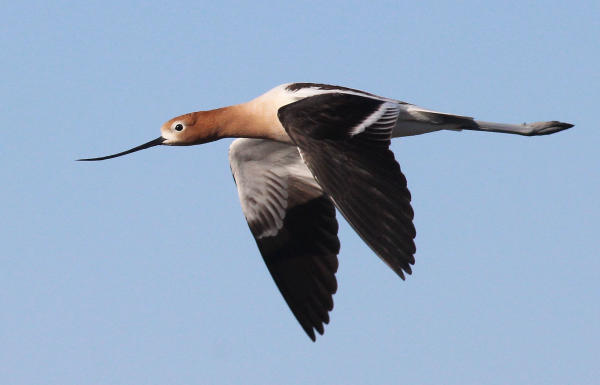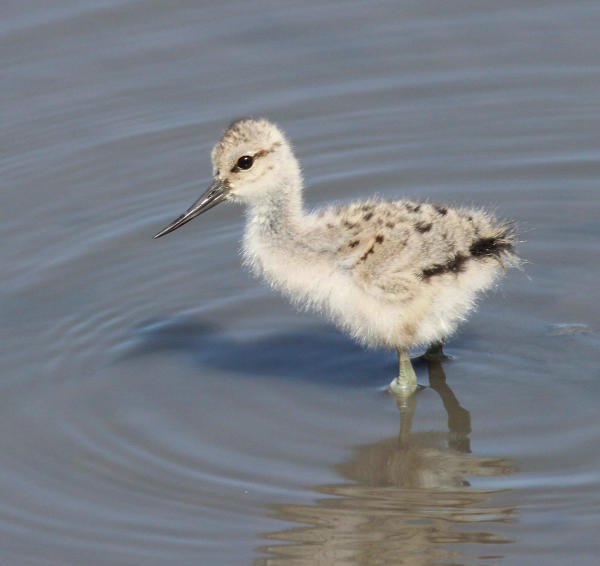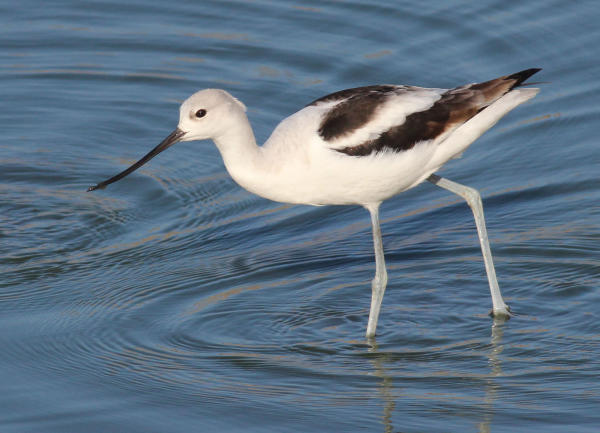
An American Avocet in flight exhibits its beautiful alternate (breeding) plumage.

A hatchling American Avocet quickly begins wading and searching for food in calm shallow water.

The basic (non-breeding) plumage of a wintering American Avocet is beautiful too.
|
Among the most beautiful and graceful-looking shorebirds, American Avocets are also one of the most aggressive when any animal or person enters their territory or comes too close to their nest or hatchlings. Avocets conduct intense and vociferous flight attacks to chase intruders away, sometimes mixed with Killdeer-like broken wing displays.
The sexes can be differentiated, but not by the usual differences in color or size that many species exhibit, but by the shape of their long thin bills. Females have a dramatically up-turned, or recurved, bill and males have an almost straight bill. Avocets often feed by sweeping their bills back and forth through the top of shallow water as they walk in search of tiny fairy shrimp and other invertebrates. Flocks of avocets can be seen feeding in this fashion.
The cinnamon-colored head and neck of American Avocets’ breeding plumage (alternate plumage), mixed with white body plumage and dramatic black and white wings makes them one of the prettiest of American birds, especially when combined with their long light-blue legs and feet. Their feet are half-webbed, and sometimes you can see avocets feeding in deeper water where they must swim while feeding or relocating to shallower water. After nesting, avocets molt into a white body plumage offset by their black and white wings.
There are four species of avocets worldwide, with the other three being Pied Avocets that range across much of the Old World, Red-necked Avocets that are found in Australia and New Zealand, and Andean Avocets that range from southern Peru through southwest South America.
Range: From the Prairie Provinces of Canada south and west of the Mississippi River. They winter south through southwest and southern coastal areas of the United States and Mexico to Central America and Caribbean islands.
Habitat: Shallow wetlands and wetland edges, mud flats, alkaline lakeshores, coastal wetlands.
Mating: Pairs are monogamous and perform dramatic mating displays that include circling, spreading wings, bowing and a bill-crossed run by a pair.
Nest Sites: The pair selects a location in the open, usually on sand or gravel. The nest is a mere scrape in the ground that they line sparsely with plant material. Pairs may nest semi-colonially with several pairs nesting a few yards apart on a small island or peninsula in a shallow wetland.
Clutch Size: 4 eggs colored tan with dark brown markings.
Incubation Period: Both female and male share incubation of the egg clutch 22 to 29 days, with the precocial hatchlings able to stand and walk in a few hours.
Nestling Period: Male and female feed and aggressively protect hatchlings at first, but young avocets begin feeding on their own just a few days after hatching.
Fledging: Hatchlings fledge in 4 to 5 weeks.
Food: Primarily small shrimp and other crustaceans, small insects and aquatic insect larvae, some aquatic vegetation and seeds.
Photographs by Paul Konrad